Introduction
Dyeing fabrics is an age-old practice that has evolved significantly over time. Aniline dyes, one of the most common synthetic dyes, have been used for a variety of materials due to their vibrant colors and adaptability. However, one frequently asked question when working with these dyes is, “Dsp de q tino con anilina seco o lavo?” (After dyeing with aniline, do I dry or wash?). Understanding the proper method to handle dyed fabrics ensures that the color adheres well, lasts longer, and retains its vibrancy.
In this comprehensive guide, we will explore the best practices when dyeing fabrics with aniline, whether you should let them dry first or wash them right away. By the end, you’ll know the exact process to follow for successful aniline dyeing, from preparation to post-dyeing care. Whether you’re a beginner or a seasoned textile artist, this guide will provide you with all the necessary details.
What is Aniline Dye?
Before diving into the topic of it’s essential to understand what aniline dye is. Aniline dye is a synthetic dye derived from coal tar and is known for its intense, brilliant colors. It’s commonly used for dyeing textiles such as cotton, wool, silk, and even leather.
Aniline dye is highly versatile, allowing for a wide range of shades depending on the concentration and the method of application. It penetrates deeply into the fibers, giving it a longer-lasting effect compared to other types of dyes. However, using aniline dye requires careful handling and a clear understanding of the process, particularly when it comes to post-dyeing care.
The Importance of Proper Dyeing Techniques

When working with aniline dyes, following the correct procedures is crucial to ensure the color binds to the fabric effectively. This includes understanding the importance of both drying and washing after the dyeing process. is a key question because the choice between drying and washing affects the overall quality and durability of the dyed fabric.
- Drying after Dyeing: Some believe that letting the fabric dry immediately after dyeing helps the dye to “set” and become more permanent. This process allows the fabric to absorb the dye fully before any further treatment, such as washing.
- Washing after Dyeing: On the other hand, washing the fabric right after dyeing can help remove any excess dye that didn’t bind to the fibers. This step is crucial for preventing color bleeding during subsequent washes and for achieving a more consistent shade.
So, how do you decide whether to dry or wash after dyeing with aniline? Let’s explore the factors that influence this decision.
Dsp de q tino con anilina seco o lavo: The Key Factors

To answer the question Dsp de q tino con anilina seco o lavo, several factors need to be considered. These factors include the type of fabric, the dye concentration, the desired result, and the dyeing method itself.
1. Type of Fabric
Different fabrics react differently to aniline dye. Natural fibers like cotton, wool, and silk tend to absorb aniline dye more effectively than synthetic materials. For natural fibers, drying the fabric immediately after dyeing can help lock in the color, ensuring that it penetrates deeply into the fibers. However, washing might be necessary to remove any excess dye, especially if the dye bath was particularly saturated.
- For cotton and wool: It is generally recommended to allow the fabric to dry first before washing. This gives the fibers enough time to absorb the dye fully.
- For silk: Silk is a delicate fabric, so drying it after dyeing is often preferred. Washing silk immediately can cause the dye to fade prematurely.
2. Dye Concentration
The concentration of the aniline dye used in the dyeing process also plays a role in determining whether to dry or wash the fabric after dyeing. If the dye solution is highly concentrated, excess dye may remain on the surface of the fabric, making washing necessary to avoid bleeding in future washes.
On the other hand, if the concentration is lower, drying first may be sufficient to ensure the dye adheres properly without the risk of excess dye being left behind.
3. Desired Outcome
The final look you want for your fabric also influences the answer t. For a more vibrant and intense color, it’s often better to dry the fabric before washing. This allows the dye to “set” and creates a deeper hue. Conversely, if you’re aiming for a softer, lighter shade, washing right after dyeing can help reduce the intensity of the color.
- For intense colors: Dry the fabric first to lock in the dye and achieve a rich, saturated hue.
- For lighter shades: Washing the fabric after dyeing can help tone down the color, resulting in a more subtle effect.
4. Dyeing Method
The dyeing technique you use also determines the post-dyeing process. Traditional immersion dyeing, where the fabric is soaked in a dye bath, often requires washing to remove excess dye. Conversely, hand-painting or direct application techniques may not require immediate washing since the dye is applied in specific areas.
Step-by-Step Guide: Dry or Wash After Dyeing with Aniline

Now that we’ve considered the key factors, let’s go through a step-by-step guide to determine whether you should dry or wash your fabric after using aniline dye.
Step 1: Prepare the Fabric
Before dyeing, it’s important to properly prepare your fabric. Wash the fabric beforehand to remove any oils, dirt, or residue that could interfere with the dye absorption. For most fabrics, using a mild detergent works best.
Step 2: Apply the Aniline Dye
Once the fabric is clean and prepared, it’s time to apply the aniline dye. Whether you’re using an immersion method, hand-painting, or a direct application, ensure that the dye is evenly distributed across the fabric. For immersion dyeing, soak the fabric in the dye bath for the recommended amount of time based on the intensity of the color you desire.
Step 3: Assess the Dye Penetration
After applying the dye, check how well the dye has absorbed into the fabric. If the color appears even and consistent, you can move on to the next step. However, if you notice uneven dye distribution, you may need to reapply the dye or agitate the fabric in the dye bath.
Step 4: Decide to Dry or Wash
Now comes the crucial decision:
- Dry First: If you’re working with cotton, wool, or silk, and you want a deep, vibrant color, allow the fabric to dry completely before washing. Hang the fabric in a well-ventilated area and avoid direct sunlight, as UV rays can cause fading.
- Wash First: If your fabric is synthetic or you used a highly concentrated dye bath, washing the fabric immediately can help remove excess dye. Rinse the fabric in cold water until the water runs clear. Be gentle during this process to avoid damaging the fabric or causing color bleeding.
Step 5: Post-Wash Care
Once your fabric has been dyed, dried, and washed (depending on your choice), it’s important to follow proper post-dyeing care. This includes washing the fabric with cold water and mild detergent during future washes to maintain the vibrancy of the color. Avoid harsh chemicals or bleach, as they can strip away the dye.
Common Mistakes to Avoid
When working with aniline dye, there are a few common mistakes that can impact the outcome of your project:
- Over-saturating the fabric: Using too much dye can lead to uneven results and excessive bleeding during washes.
- Skipping the drying phase: For certain fabrics, skipping the drying phase before washing can result in faded colors and poor dye adherence.
- Not following fabric-specific instructions: Each fabric reacts differently to aniline dye, so always consider the specific needs of your material.
Conclusion
So, The answer depends on several factors, including the type of fabric, the dye concentration, and the desired outcome. In most cases, drying the fabric first helps lock in the dye and ensures a vibrant, long-lasting color. However, washing immediately after dyeing may be necessary for certain fabrics or if you want a lighter shade.
By following the steps outlined in this guide, you can confidently dye fabrics with aniline and achieve the best possible results. Whether you choose to dry or wash your fabric after dyeing, remember that proper care and attention to detail are key to successful fabric dyeing.
